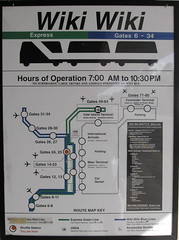I realized I didn't have a way to find our which blogpost was most often read, though I notice my 10 online icebreakers are often linked too. Through the communities and networks connection site, which aggregates several blogs including mine, I was able to click on my own name and see the best of. My best of are written in 2006 and 2008... But there is one surfacing from 2009:
Can you shift your organisational culture by introducing social media? It's a question by which I'm still intrigued. So here we go:
 image through ericmackonline.com
image through ericmackonline.comThis post may be a little chaotic as I'm using it to get a grip on some of my ideas about social media for organisations. Tomorrow I'm going to write with Sibrenne Wagenaar; we are writing a booklet on social media for learning and collaboration. We start with social media for professionals (individuals), then teams, then organisations. It's the organisational chapter that needs much more thinking. I once asked on twitter whether the exchange on twitter is not similar to the chats with your co-located workers. Someone replied that is it not, that on twitter people are far more open to sharing and helping each other. This started me thinking about the fact that introducing an internal twitter system would NOT make people share. The term enterprise2.0 is often used. But is that an open, creative organisation or is it an organisation with web2.0 tools? In my opinion, an organisation with less web2.0 tools could be more 'enterprise2.0' in terms of culture than an organisation that has a lot of web2.0 tools but lacks the culture.
One confusion is brought by the fact that organisations can embrace social media from so many different angles. I see a higher emphasis on social media from a marketing perspectives than from a learning perspective. If you jump on it for marketing purposes, you will have a different focus and process than when you want to explore how social media can stimulate learning and knowledge sharing processes. But probably in both cases, it has to match your organisational culture too.
Tools and culture: is your organisational culture ready for social media or do you want to shift the culture by introducing social media?. I'm re-reading Schein: organisational culture and leadership. Schein explains very well how cultures are created and reproduced. And that it's possible to influence cultures in organisations. At times I hear that an organisation is using wikis. Or uses Sharepoint internally with the blog function. An organisation seems enterprise2.0 enough because it has tools like blogs, wikis and social bookmarking. However, the juice of social media is far more in the culture of openly sharing knowledge, collaboration, and engaging in co-creation. Having the tools does not mean you have improved the collaboration between your professionals. So what is the actual change that you are envisioning? Can social media play a role in this? But what are the other interventions that are needed to help change the organisational culture? I see a lot of potential for change management professionals to help organisations with this process. On the other hand, there may be organisations that are already having an open culture in which social media fit neatly. But probably these organisations do not need any accompanying change process or at least a different process? So you'd have to start with assessing the culture of the organisation and see whether there is a match or a mismatch with social media cultures.
Another dilemma is how to balance individual preferences and creativity versus uniformity in tools. Back to the original question: what organisational processes do you feel can really be supported by social media? What is the organisational change that you envisage? I don't think there is any organisation that is completely enterprise1.0. I'm sure there are employees engaging in social media individually and that most do use wikipedia for instance. But a real enterprise2.0 is an open, collaborative, creative organisation that leverages the tools to the advantage of the functioning of the organisation. In this organisation: do professionals choose their own tools and are proficient in using them or do they work with the preferential toolset of the organisation?
By the way a nice guide of where to start with social media can be found here on the technotheory blog. However, this is also written from the assumption that you use social media to promote your organisation or products, not to stimulate internal learning processes.

![Reblog this post [with Zemanta]](http://img.zemanta.com/reblog_e.png?x-id=b3705e9f-7d94-4594-9976-a4f820dc468a)

![Reblog this post [with Zemanta]](http://img.zemanta.com/reblog_e.png?x-id=5ed79a60-9b09-462c-b73a-67ae924034b9)

![Reblog this post [with Zemanta]](http://img.zemanta.com/reblog_e.png?x-id=884385af-3ccb-4260-a15f-26b38edea05c)

![Reblog this post [with Zemanta]](http://img.zemanta.com/reblog_e.png?x-id=a3277252-b1e8-4740-b820-a575a53cb6fb)

![Reblog this post [with Zemanta]](http://img.zemanta.com/reblog_e.png?x-id=c257e0be-dbb3-451c-b69c-b13232dc4542)

![Reblog this post [with Zemanta]](http://img.zemanta.com/reblog_e.png?x-id=7a0b0e58-fa17-46a0-9c95-a02af394be30)

![Reblog this post [with Zemanta]](http://img.zemanta.com/reblog_e.png?x-id=5a89cfaf-d82e-4860-9e31-0ee0106446a0)

![Reblog this post [with Zemanta]](http://img.zemanta.com/reblog_e.png?x-id=c9d74d0c-d271-4c16-9951-e62b07c987ef)

![Reblog this post [with Zemanta]](http://img.zemanta.com/reblog_e.png?x-id=d5826ffd-7b2b-4489-9924-aab3a64403b7)



![Reblog this post [with Zemanta]](http://img.zemanta.com/reblog_e.png?x-id=4125da3e-99c5-4bc2-86e6-b6183b54328a)

![Reblog this post [with Zemanta]](http://img.zemanta.com/reblog_e.png?x-id=9110183e-a832-407d-8cc8-9d850580cc94)
![Reblog this post [with Zemanta]](http://img.zemanta.com/reblog_e.png?x-id=341f44cd-6b58-46f6-8c57-3fdf4dfd94c3)
